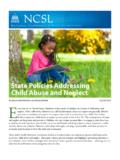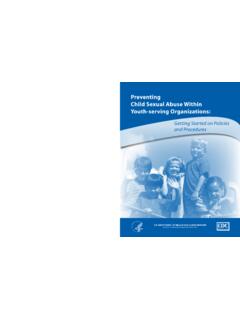Transcription of THE SPIRAL OF SEXUAL ABUSE
1 THE SPIRAL OF SEXUAL ABUSE A conceptual framework for understanding and illustrating the evolution of sexually abusive behaviour Joe Sullivan MA (Crim) BA (Hons) CQSW Dip Psy Principal Therapist The Lucy Faithfull Foundation January 2002 2 This article is based on a presentation given by the author to The International Conference on Violence Towards Children, in Lisbon, Portugal in February 2000 and repeated at a NOTA conference workshop in September 2001. THE PROCESS OF CHANGE It is impossible to effectively intervene in a process, which you do not understand.
2 For professionals working in the area of child SEXUAL ABUSE it is important to understand how ABUSE works. Whether you are a therapist helping an offender learn how to control the urge to sexually offend, or a social worker assisting a family adjust to the impact of an abuser s influence, or whether you are a law enforcement officer investigating or monitoring a suspect, not understanding the process can have significant consequences. Nor should this information be kept for the professionals. If offenders are to change and families are to protect children, they too must understand how the process works in order to be effective in terms of child safety.
3 Both Steven Wolfe (1984) and David Finkelhor (1986) have suggested theories to explain how SEXUAL offending works. Some clinicians have adapted these theories and developed models, which are designed to assist a more general population in understanding the processes involved in SEXUAL offending. WOLFE (1984) - CYCLE OF SEXUAL OFFENDING Although never more than a conference paper Wolfe s theory has been influential in shaping the understanding of SEXUAL offending and illustrating the stages perpetrators will progress through, in the lead up to, and immediately following the ABUSE (Fig.)
4 1). The model continues to be a central tenet of most cognitive behavioural sex offender treatment programmes. The cycle contains many of the most common features of any perpetrator s process of sexually abusing children. It is important for therapists not to attempt to make the offender fit the cycle but rather to use the framework as a means by which they can acknowledge the structure of their developing behaviour and explore it in detail. 3 THE CYCLE OF OFFENDINGRef: S. Wolf (1984)MotivationInternal inhibitors operating ..TRIGGERI llegal SEXUAL FantasyMasturbation/orgasmTarget victimGrooming OthersFantasy RehearsalABUSEFear ofDetection/Guilt(?
5 Fantasy ReinforcementCOGNITIVEDISTORTIONSG room VictimPro-offending thinking/behavior Hilary Eldridge (1990) developed the work of Wolfe by introducing the concepts of continuous cycle , the inhibited and the short-circuit cycle . These cycles essentially explore the particular route an offender will take after the commission of the offence. In the case of a continuous cycle (Fig. 2) an offender will recover each of the stages of the cycle, selecting a new victim each time. This is perhaps, most common in the case of with an offender with an indecent exposure pattern, for example, where having sexually offended he will repeat the pattern in its entirety.
6 In the case of the inhibited cycle (Fig. 3), the perpetrator becomes blocked or inhibited following the commission of an offence and may stop for a period of time. In time the perpetrator finds a means by which they can overcome these inhibitors and progress through the various stages of their cycle to the commission of another offence. Typically, this cycle relates to a perpetrator who Fig 1 Fig 2 THE CONTINUOUS CYCLE Ref: Hillary Eldridge (1990)Illegal SEXUAL FantasyMasturbation/orgasmTargetvictimGr ooming/PlanningFantasy RehearsalABUSEFear ofDetection/Guilt(?)Fantasy ReinforcementTHE INHIBITED CYCLERef: Hillary Eldridge (1990)Internal inhibitors operating.
7 TRIGGERI llegal SEXUAL FantasyMasturbation/orgasmTarget victimGrooming/PlanningFantasy RehearsalABUSEFear ofDetection/Guilt(?)Fantasy ReinforcementFig. 3 4selects a new victim each time they offend and consequently return to general illegal SEXUAL fantasy before choosing their next victim. In the short circuit cycle (Fig. 4) the perpetrator does not become inhibited following the commission of the offence but rather returns to the cycle at the point of fantasy rehearsal and speeds up. In this case the perpetrator continues to ABUSE either the same child or in a similar manner. This cycle is typical where the perpetrator is abusing a child in the family or within a context where they will have contact with the child .
8 FINKELHOR (1986) PRECONDITIONS OF SEXUAL OFFENDING Finkelhor, in his research, has explored the motivations of offenders for engaging in SEXUAL ABUSE and suggested four preconditions to SEXUAL offending. Practitioners and clinicians have sought to illustrate this theory in a variety of ways. One method is to describe the preconditions as hurdles on a racecourse. Motivation to sexually offend would be the start line, internal inhibitors; external inhibitors and victim resistance would be the three hurdles, which an individual must negotiate in order to sexually offend.
9 Fig. 5 illustrates this clinical application of Finkelhor s four pre-conditions to SEXUAL offending. Finkelhor A clinical application Adapted by Joe Sullivan from:- D Finkelhor child SEXUAL ABUSE : New Theory & Research 1986 MOTIVATION Wanting to INTERNALINHIBITORS Conscience OVERCOMEVICTIM RESISTANCE Doing it and getting away with it EXTERNAL INHIBITORS Creating Opportunity ThoughtsSex witha child Fig. 5 THE SHORT-CIRCUIT CYCLE Ref: Hillary Eldridge (1990)Illegal SEXUAL FantasyMasturbation/orgasmTarget victimGroomingOthersFantasy RehearsalABUSEG rooming VictimFig. 4 5 THE SPIRAL OF SEXUAL ABUSE The concept of the SPIRAL of SEXUAL ABUSE has been developed as a result of clinical assessment and treatment work with several hundred SEXUAL ABUSE perpetrators.
10 Primarily, it has been used as a clinical tool to assist perpetrators to fully explore their pattern of SEXUAL offending, however, it has also been useful in assisting professionals, unfamiliar with the concepts, to better understand perpetrator behaviour. From the practitioner perspective, the SPIRAL seeks to address some of the difficulties implicit in a clinical application of previous models. The SPIRAL retains many of the features of the work of Wolfe and Finkelhor and as such is not intended to replace these theories, rather expand upon them. One of the benefits of the conceptual framework of a SPIRAL is that it lends itself to illustrating the developing and escalating nature of ABUSE .














